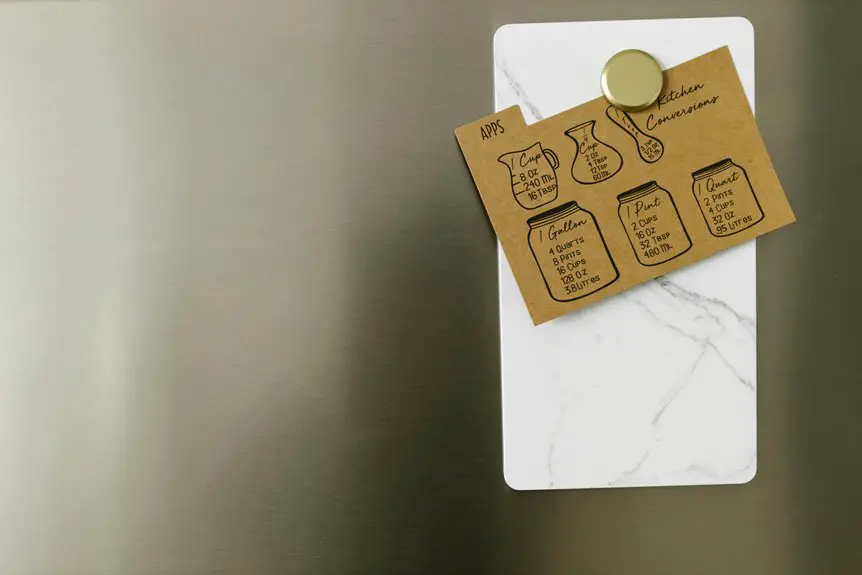When managing cables, knowing the size and type is crucial. Thicker cables need larger clips, while thinner ones can use smaller attachments. Nail-in, adhesive, and saddle clips serve different purposes based on your setup. Always measure cable diameters for proper fit and choose the right material for durability. With a little preparation and planning, you can improve your workspace's organization and aesthetics. Stick around to discover essential tips for installation and maintenance!
Table of Contents
Key Takeaways
- Measure the diameter of your cables to select the appropriate clip size for effective management.
- Choose thicker clips for larger cables like power cords, and smaller clips for thinner cables like USB or HDMI.
- Consider the clip material; plastic is lightweight while metal offers more durability for heavy-duty applications.
- Use nail-in clips for permanent setups on walls, and adhesive clips for temporary or smooth surface applications.
- Regularly check and maintain clip placements to ensure cables remain secure and organized over time.
Understanding Different Cable Sizes
When you're organizing your cables, understanding different cable sizes is crucial for effective management. Cables come in various thicknesses and lengths, impacting how you store and secure them.
For instance, thicker cables, like power cords, require larger clips to avoid damage and ensure a snug fit. On the other hand, thinner cables, such as USB or HDMI, can be managed with smaller clips.
Knowing the diameter of your cables helps you choose the right clips, preventing tangling and wear. Accurate measurements will also save you time and frustration during setup or troubleshooting.
Types of Cable Clips Available
Numerous types of cable clips are available to suit various needs and preferences. Each type serves a specific purpose, making it easier for you to manage your cables effectively.
Here are three common types you might consider:
- Nail-in cable clips: These clips are perfect for securing cables to walls or baseboards, providing a sturdy hold without damaging the cables.
- Adhesive cable clips: Ideal for smooth surfaces, these clips stick easily and are great for temporary setups or areas where you don't want to drill holes.
- Saddle clips: These clips are designed to hold multiple cables together, keeping them organized and preventing tangling.
Choosing the right clip can enhance your workspace, ensuring cables are neat and accessible.
Choosing the Right Clip for Your Cables
Selecting the right cable clip is key to maintaining an organized and efficient workspace. Start by measuring the diameter of your cables; choosing clips that match these dimensions ensures a snug fit.
If you're dealing with multiple cables, opt for clips designed to accommodate different sizes or bundles. Consider the material of the clip too; plastic clips are lightweight and versatile, while metal clips offer durability for heavier cables.
Additionally, think about where you'll be placing the clips. For walls or desk edges, adhesive-backed clips are convenient, while screw-in options provide extra stability.
Installation Tips for Cable Clips
When you're ready to install cable clips, proper surface preparation is key to a secure hold.
Make sure the surface is clean and dry before applying the clips, as this helps them stick better.
Also, choosing the right size clip for your cables ensures they stay organized without causing damage.
Surface Preparation Techniques
Proper surface preparation is crucial for effective installation of cable clips, ensuring they adhere securely and function well.
To achieve the best results, follow these steps:
- Clean the Surface: Remove dust, grease, or other debris from the area where you'll install the clips. Use a cloth or a cleaner suitable for the surface material.
- Dry the Area: Make sure the surface is completely dry before applying the clips. Moisture can weaken adhesive bonds and lead to premature failure.
- Mark the Placement: Use a pencil or marker to indicate where each clip will go. This ensures accurate spacing and alignment, making your installation look professional.
Proper Clip Sizing
After ensuring your surface is clean and dry, choosing the right size of cable clips is key for a secure installation. Measure your cables' diameter accurately; this will guide you in selecting clips that fit snugly without being too tight.
A clip that's too small can damage the cables, while one that's too large may not hold them securely. When installing, position the clips at regular intervals to prevent cables from sagging or being pulled.
If your cables vary in size, consider using adjustable clips or a mix of sizes. Always double-check that the clips are firmly anchored to the surface, and test the setup before finalizing the installation to ensure everything stays in place.
Organizing Cables in Various Settings
Organizing cables in various settings can significantly enhance your workspace's aesthetics and functionality.
By tackling the chaos of tangled wires, you'll create a more efficient environment. Here are three effective strategies to consider:
- Use Cable Clips: Secure cables along walls or desks to keep them in place and prevent tangles.
- Label Your Cables: Clearly labeling each cable helps you quickly identify which device it belongs to, saving you time during setup or troubleshooting.
- Cable Management Boxes: Invest in cable management boxes to hide excess cables, giving your space a clean and organized look.
Implementing these methods won't only streamline your workspace but also improve your overall productivity.
Maintenance and Care for Cable Clips
While cable clips can greatly enhance your organization, maintaining them is essential for long-lasting effectiveness.
Start by regularly inspecting your clips for wear and tear. If you notice any cracks or breaks, it's time to replace them.
Keep the area around the clips clean to prevent dust and debris from accumulating, which can impact their adhesive strength.
When applying clips, ensure the surface is dry and smooth for optimal adhesion. For removable clips, reposition them carefully to avoid damaging surfaces.
Lastly, avoid overloading clips with too many cables, as this can lead to breakage.
Frequently Asked Questions
Can Cable Clips Be Reused After Removal?
Yes, you can reuse cable clips after removal, but their effectiveness may diminish. If they're still intact and the adhesive isn't damaged, you can simply reapply them to manage your cables again.
Are Cable Clips Suitable for Outdoor Use?
Yes, cable clips can be suitable for outdoor use, but you should check their material. If they're made of weather-resistant plastic or metal, they'll hold up well against moisture, UV rays, and temperature changes.
Do Cable Clips Damage the Cables?
Cable clips typically don't damage your cables if used properly. Just ensure they're the right size and material for your cables. Avoid over-tightening, as that can cause wear or stress on the cables themselves.
How Many Cables Can One Clip Hold?
One clip typically holds one to three cables, depending on their thickness. If you're working with thicker cables, stick to one. Always check the clip's specifications to ensure a secure fit for your needs.
What Materials Are Cable Clips Made From?
Cable clips are typically made from durable materials like plastic, metal, or rubber. You'll find that each material offers different benefits, such as flexibility, strength, or resistance to heat. Choose based on your specific needs.




